Key Points:
- There are over 500 species of primates including monkeys, apes, lorises, lemurs, and chimpanzees.
- Neanderthals are an extinct subspecies of humans who inhabited Eurasia and went extinct 40,000 years ago. Adults had an average height of six feet tall and weighed up to 180 pounds.
- The koala lemur was a leaf-eating giant lemur native to Madagascar that went extinct between 2000 – 500 years ago.
There are over 500 species of primates on planet Earth. This sounds like a lot, but it’s just a handful compared to what has existed in the long procession of primate evolution. Here are seven extinct primates. Some are prehistoric, but others have only become extinct in the past few centuries.
Before we dive in, what exactly is a primate?
What Is A Primate?
A primate is a type of mammal. There are over 500 species of primates alive today. They include humans, monkeys, apes, lorises, lemurs, and chimpanzees. It’s the third most diverse group after rodents and bats and one of the most social.
Primates appeared 85–55 million years ago and are characterized by their large brains, excellent visual acuity (that means they can see small details), and dexterous hands.
So now we know what a primate is, let’s learn about extinct primates.
1. Neanderthals (Homo neanderthalensis)

Neanderthals are an extinct sub-species of humans.
©IR Stone/Shutterstock.com
Neanderthals are an extinct subspecies of humans. They lived in Eurasia but went extinct about 40,000 years ago.
They had long skulls and large brows over their eyes. Fossilized remains also show they had larger, wider noses and pointier faces than humans. Some scientists think larger noses warmed up the Ice Age air and made breathing easier.
They had stocky builds and strong bodies. Adults grew to around six feet tall and weighed up to 180 pounds. They lived in limestone caves, created stone tools, and hunted animals for food and skin. It’s likely they also ate fruits and vegetation when it was available.
Scientists aren’t sure why Neanderthals are extinct. There’s a lot of debate, but some have suggested that the population size was very small, which led to inbreeding. Modern humans (our ancestors) started to appear in Europe around the time Neanderthals became extinct so that it could be that early humans (homo sapiens) outcompeted them. This article from Plos One explains how homo sapiens may have outcompeted Neanderthals.
The fossil record indicates Neanderthals went extinct slowly, suggesting they were replaced over time rather than dying out due to a catastrophic event.
2. Chororapithecus (Chororapithecus abyssinicus)

If Chororapithecus lived in this environment, it’s very similar to the habitats of today’s great apes.
©Didier Descouens / CC BY-SA 4.0 – License
This extinct great ape from Ethiopia lived around 8 million years ago. Its name means ‘ape from Chorora.’ Paleontologists know little about it because all that’s ever been found are nine teeth! Only one species has been found so far.
The toothy remains were found near the village of Chorora in Ethiopia in 2005-07, and they are very similar to gorilla teeth. This has led scientists to theorize that chororapithecus is the gorilla’s oldest relative, but because there are so few remains, it’s far from certain.
Its teeth were made for shearing and mashing plant fibers, and the thick enamel resembles orangutans that eat brittle foods such as nuts. The fossilized remains were found in a river system that possibly had a forest beside it. If Chororapithecus lived in this environment, it’s very similar to the habitats of today’s great apes.
3. Gigantopithecus (Gigantopithecus blacki)

Gigantopithecus blacki may have been an ancestor of today’s orangutans
©tristan tan/Shutterstock.com
Gigantopithecus blacki is an extinct primate that gets its name from its gigantic size. It’s the biggest primate ever found.
Its fossils were discovered in 1935 by a German paleontologist who found them in a Chinese pharmacy labeled as ‘dragons teeth.’ Some jaw bones and other teeth were unearthed in India, south China, and Vietnam in the following years.
There’s little evidence to go on, but paleontologists think it was a forerunner of our orangutans and stood up to ten feet tall. Its weight is estimated at 595 pounds – that’s the same as a grizzly bear.
Its teeth suggest it lived and ate in forests 1 million years ago and became extinct 100,000 years ago. This was a time when climate change affected forests, becoming less abundant. It’s likely this gigantic ape wasn’t able to find enough food to sustain its huge size, so it gradually died out.
4. Pierolapithecus (Pierolapithecus catalaunicus)
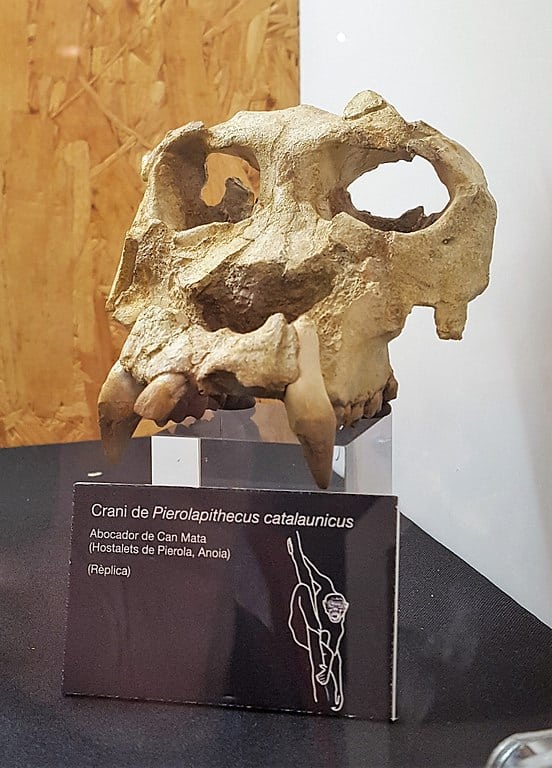
Pierolapithecus had flexible wrists with short fingers and toes to climb trees and likely had a sloped face similar to today’s chimps.
©Nasobema lyricum / CC0 1.0 – License
Thirteen million years ago, Pierolapithecus lived in modern-day Spain. Fossilized remains found in Els Hostalets de Pierola indicate it weighed around 75 pounds (similar to an adult male orangutan) with a wide ribcage similar to modern apes.
It had flexible wrists with short fingers and toes to climb trees and likely had a sloped face similar to today’s chimps and tree-climbing monkeys.
Scientists think it may be the last common ancestor of orangutans and humans before the genus split.
5. Hispaniola Monkeys (Antillothrix bernensis)
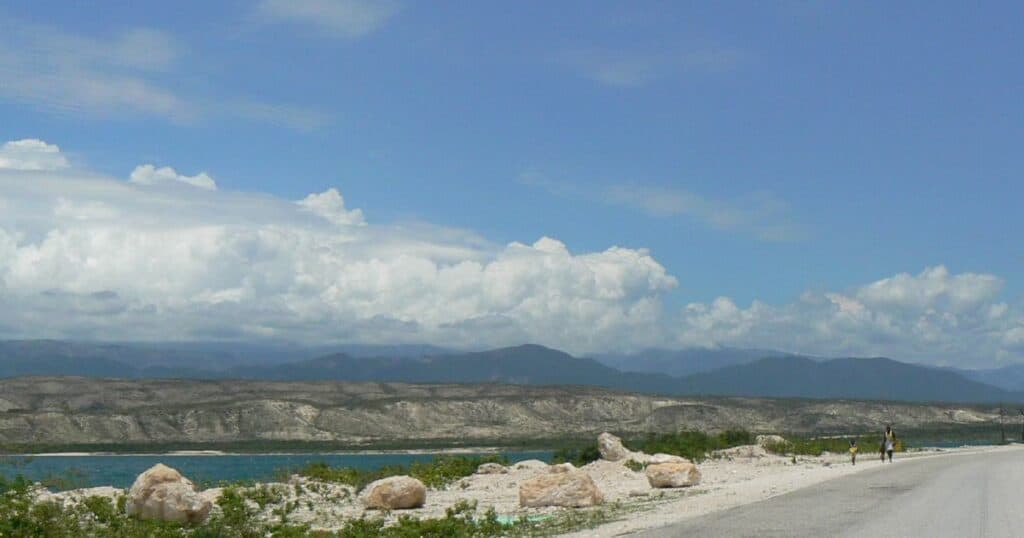
Hispaniola monkeys were endemic to the Dominican Republic
Hispaniola monkeys were capuchin-like monkeys that lived in Hispaniola until Columbus arrived and Europeans began to colonize the Caribbean in 1492.
Scientists don’t know what they looked like, but today’s capuchins reach around 22 inches long and weigh up to nine pounds. They have long tails and brown-white fur. It’s possible Hispaniola monkeys were similar, but we will never know for sure.
They were endemic to the island of Hispaniola, which is now part of the Dominican Republic. Recent evidence from the fossil record suggests they disappeared in the 16th century after years of decline. Most likely, their habitats were cleared for farming, and there have been no primates in the Caribbean since.
6. Mount Kenya Potto (Perodicticus potto stockleyi)
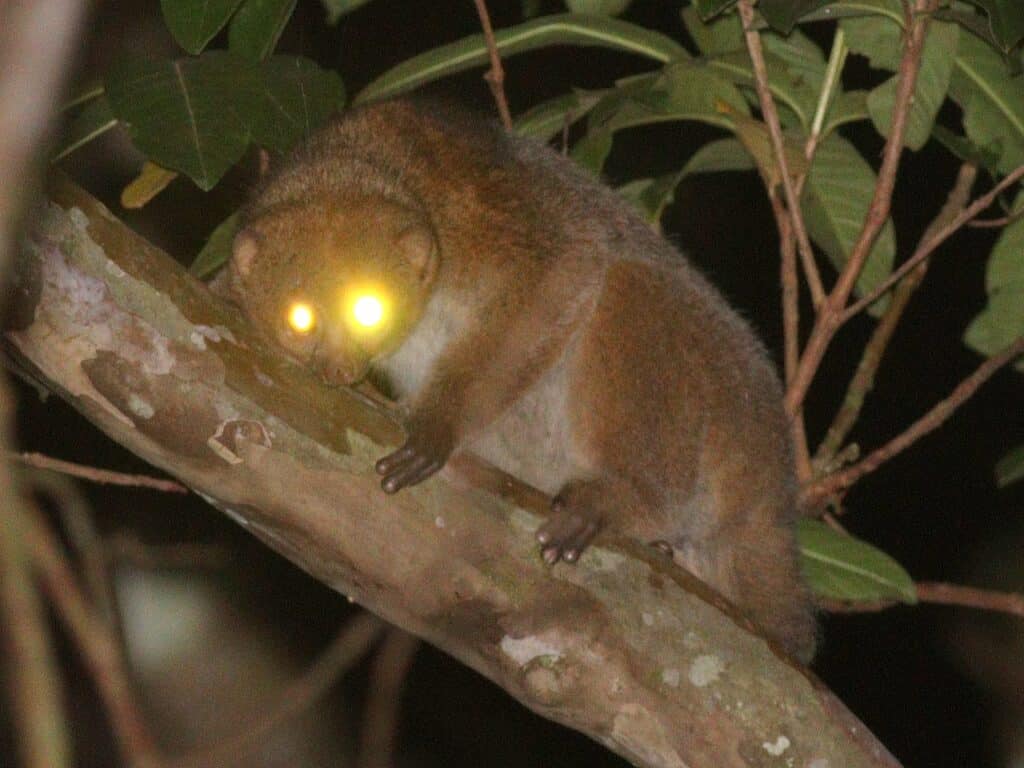
While the Mount Kenya Potto is extinct, it was a subspecies of the East African Potto which still exists in the wild.
©Telegro / CC BY-SA 4.0 – License
Pottos are small nocturnal primates with stumpy tails. They are notoriously shy and remain so well camouflaged even today’s scientists find it hard to spot them.
Mount Kenya Potto is known from only one 1938 specimen. It weighed 3.3 pounds, was small-bodied with dark brown thick fur, and had agile, thin fingers for gripping branches.
Scientists have tried to find the Mount Kenya potto since 1999, but no sightings have been recorded. It’s not certain if this little potto is clinging on under cover or if it’s extinct.
Because this small primate lives in a limited environment of wet forestland, their reliance on such a small area makes them vulnerable to climate change and forest clearance.
Fingers crossed for the Mount Kenya potto.
7. Koala Lemur (Megaladapis edwardsi)
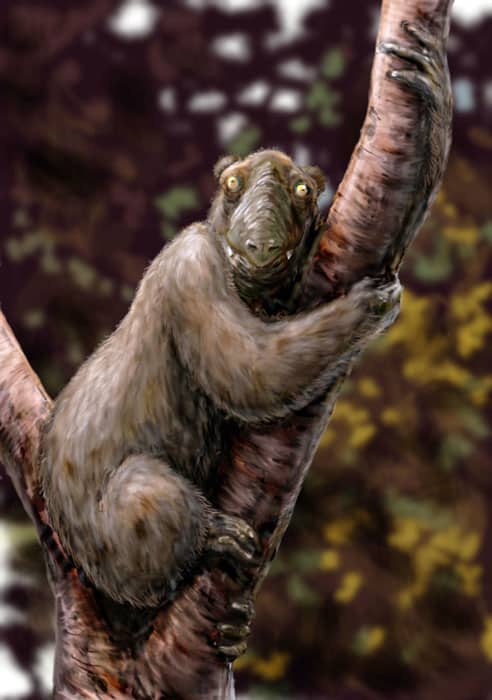
Giant lemurs’ arm, leg, and wrist structures indicate to paleontologists that they didn’t walk on the ground much.
©FunkMonk (Michael B. H.) / CC BY-SA 3.0, , via Wikimedia Commons – License
Leaf-eating giant lemurs were numerous in ancient Madagascar. There were at least 17 species, but the biggest found is the koala lemur.
It was human-sized (five feet) and weighed around 187 pounds, with koala-type paws that give it the common name koala lemur. But that’s where any similarities end. Giant Madagascan lemurs didn’t look like today’s lemurs. They were squat like a koala with long arms and legs, a cow jaw, and a long snout. Unusually, their eyes were on the side of their heads rather than forward-facing like other primates.
Giant lemurs’ arm, leg, and wrist structures indicate to paleontologists that they didn’t walk on the ground much. Instead, they lived in an arboreal environment, sticking to the safety of trees.
This odd-looking primate became extinct 2000-500 years ago, most likely due to deforestation and clearance for farming.
Today there are 100 lemur species in Madagascar, but none reach this gigantic size.
Today’s Endangered Primates
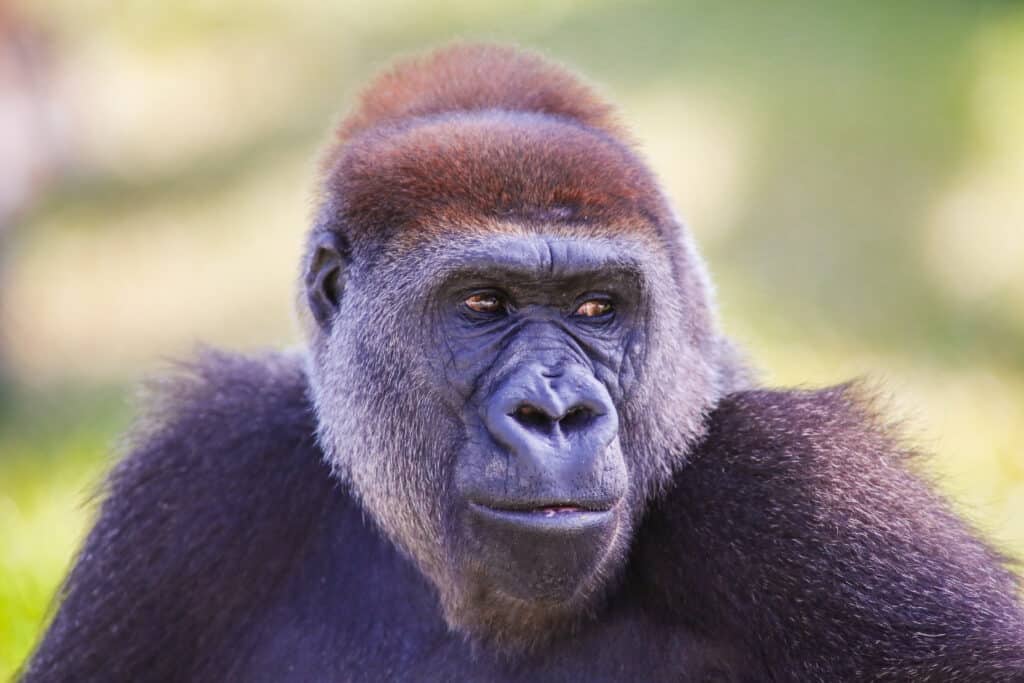
Out of the gorilla species, Cross River Gorillas are the smallest.
©Kit Korzun/Shutterstock.com
Forty-two percent of today’s modern primates are critically endangered. This includes Cross River gorillas and Tapanuli orangutans which are down to their last few hundred individuals.
Without proper conservation and a huge effort by governments, this extinct primates list might grow even longer.
Summary Of 7 Extinct Primates
| Rank | Extinct Primate | Date of Extinction |
|---|---|---|
| 1 | Neanderthals (Homo neanderthalensis) | 40,000 years ago |
| 2 | Chororapithecus (Chororapithecus abyssinicus) | 8 million years ago |
| 3 | Gigantopithecus (Gigantopithecus blacki) | 100,000 years ago |
| 4 | Pierolapithecus (Pierolapithecus catalaunicus) | 13 million years ago |
| 5 | Hispaniola Monkeys (Antillothrix bernensis) | 1700s |
| 6 | Mount Kenya Potto (Perodicticus potto stockleyi) | Last record 1938 |
| 7 | Koala Lemur (Megaladapis edwardsi) | 2000-500 years ago |
The photo featured at the top of this post is © Roni Setiawan/Shutterstock.com
Thank you for reading! Have some feedback for us? Contact the AZ Animals editorial team.







